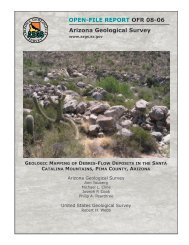Conglomerate Clast Counts in Oligocene-Miocene Strata North
Conglomerate Clast Counts in Oligocene-Miocene Strata North
Conglomerate Clast Counts in Oligocene-Miocene Strata North
Create successful ePaper yourself
Turn your PDF publications into a flip-book with our unique Google optimized e-Paper software.
et al., 2002), but San Manuel equivalents appear to overstep Cloudburst equivalents to rest<br />
directly on mid-Tertiary volcanic rocks <strong>in</strong> the northern part of the homocl<strong>in</strong>e (Fig. 2).<br />
Well exposed transects of strata with<strong>in</strong> the Guild Wash allochthon are rare ow<strong>in</strong>g to the low<br />
overall relief of weathered exposures and widespread alluviated terraces along Cadillac Wash<br />
and its tributaries. No systematic paleocurrent data is available from the Guild Wash allochthon,<br />
and the direction that provenance areas lay from present exposures is unknown, but suitable clast<br />
transects embrac<strong>in</strong>g both Cloudburst and San Manuel strata were located along Parker Wash to<br />
the south (transect A of Fig. 2) and Olsen Wash to the north (transect B of Fig. 2). <strong>Clast</strong>s were<br />
counted <strong>in</strong> streamcut outcrops beside alluviated wash floors, but volcaniclastic beds present at<br />
lower Cloudburst horizons were not counted.<br />
Cloudburst counts (Table 2AB) record an <strong>in</strong>verted clast stratigraphy, with beds dom<strong>in</strong>ated by<br />
clasts derived largely from mid-Tertiary volcanic rocks succeeded upward stratigraphically by<br />
beds that are dom<strong>in</strong>ated by clasts derived from Precambrian Oracle Granite. This trend <strong>in</strong> clast<br />
composition apparently reflects unroof<strong>in</strong>g of basement from beneath volcanic cover <strong>in</strong> the<br />
provenance area dur<strong>in</strong>g Cloudburst sedimentation. On the south (Parker Wash), clasts <strong>in</strong> the<br />
overly<strong>in</strong>g San Manuel succession (Table 2A) were derived predom<strong>in</strong>antly from Precambrian<br />
basement (primarily Oracle Granite and secondarily P<strong>in</strong>al Schist). On the north (Olsen Wash),<br />
however, San Manuel clasts were derived <strong>in</strong> subequal proportions from Oracle Granite and mid-<br />
Tertiary volcanic rocks (Table 2B). The areal variability of San Manuel clast counts with<strong>in</strong> the<br />
Guild Wash allochthon suggests derivation from multiple local dra<strong>in</strong>ages tapp<strong>in</strong>g basement<br />
overla<strong>in</strong> variably by residual volcanic cover. The volcanic cover was at least locally removed by<br />
erosion before emplacement of the granite-clast megabreccia that forms the uppermost exposed<br />
horizon of the San Manuel succession.<br />
Star Flat Allochthon<br />
Cloudburst and San Manuel strata <strong>in</strong> the Star Flat allochthon (Fig. 3) form an east-dipp<strong>in</strong>g<br />
homocl<strong>in</strong>e that abuts downdip <strong>in</strong>to a subhorizontal detachment fault (Dick<strong>in</strong>son, 1994) that is<br />
exposed along the north side of the allochthon, repeated on the east across a local normal fault,<br />
and upturned on the west to dips of 55˚-65˚ along the western edge of the exposed allochthon<br />
(<strong>in</strong>set map of Orr et al., 2004). San Manuel strata consistently dip more gently (5˚-15˚) than<br />
underly<strong>in</strong>g Cloudburst strata (55˚-85˚), and unconformably overlap <strong>in</strong>terf<strong>in</strong>ger<strong>in</strong>g units of<br />
Cloudburst sedimentary strata and mid-Tertiary volcanic rocks. The San Manuel Formation is<br />
nowhere <strong>in</strong> contact with the Star Flat detachment fault (Fig. 2), and was probably deposited after<br />
displacement of the Cloudburst Formation along the detachment fault, which was <strong>in</strong>cl<strong>in</strong>ed to the<br />
west dur<strong>in</strong>g fault slip but has been backtilted by fault rotation to easterly dips.<br />
No systematic paleocurrent data are available from the Star Flat allochthon, which is exposed for<br />
the most part <strong>in</strong> subdued upland topography, but clasts were counted <strong>in</strong> a contiguous section of<br />
Cloudburst and San Manuel strata exposed along Bloodsucker Wash (transect C of Fig. 2) just<br />
north of the Willow Spr<strong>in</strong>gs Ranch. <strong>Clast</strong>s <strong>in</strong> exclusively volcaniclastic Cloudburst beds directly<br />
overly<strong>in</strong>g or <strong>in</strong>terf<strong>in</strong>ger<strong>in</strong>g with mid-Tertiary volcanic rocks were not counted. Stratigraphically<br />
higher <strong>in</strong> the local section (Table 2C), clasts of mid-Tertiary volcanic rock and Precambrian<br />
Oracle Granite are jo<strong>in</strong>tly dom<strong>in</strong>ant <strong>in</strong> subequal proportions <strong>in</strong> both the Cloudburst and San<br />
6

















